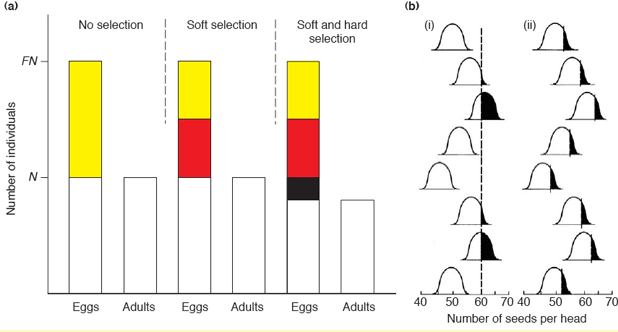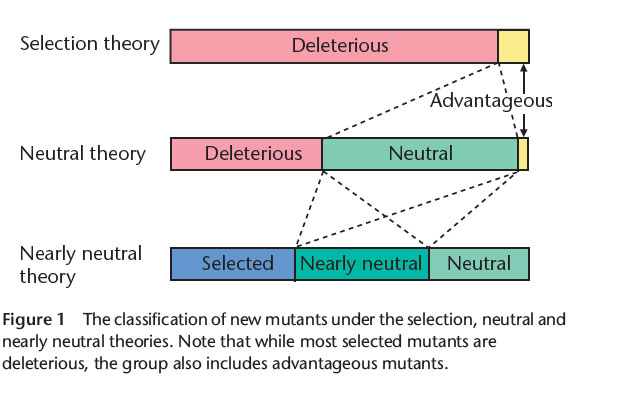Natural selection can operate without running up an impossible genetic load if it is soft selection rather than hard selection
* Soft selection: selective deaths are substituted for non selective background mortality
* Hard selection: selection occurs as extra mortality, which occurs on top of the background mortality
 Figure I. Representations of hard and soft selection. (a) The concept of hard and soft selection (with respect to population density only, for simplicity not showing frequency dependence). A population of N adults with average fecundity of 2F per female produces FN eggs. As maximum adult population size is limited to N by some external factor, such as availability of space or food, 2F–N eggs must die each generation. This mortality can be random with respect to genotype and, therefore, non-selective (in yellow), or selective (soft selection, in red), but cannot depress population size below N. Hard selection (in black) introduces an additional, density independent source of mortality, which reduces population size below N. (b) An early representation of hard versus soft selection in the context of a metapopulation. In(i), the small-grain breeder saves all heads bearing 60 or more seeds for planting and future selection; some experimental plots are entirely discarded under this scheme. In (ii), the breeder first samples a few heads from plants of each experimental plot, determines the statistical distribution of seeds per head for each plot, and then harvests what is estimated to be the best 5% of all heads of each plot for planting and further selection. Under this scheme, a few heads are saved from each plot regardless of its average number of seeds per head. Soft selection resembles the second scheme, hard selection the first. Black shading indicates those individuals that were selected to reproduce, no shading those that were not selected. selection incorporates the idea that most populations appear to be at K, and mortality becomes more selective as get nearer to K.
Figure I. Representations of hard and soft selection. (a) The concept of hard and soft selection (with respect to population density only, for simplicity not showing frequency dependence). A population of N adults with average fecundity of 2F per female produces FN eggs. As maximum adult population size is limited to N by some external factor, such as availability of space or food, 2F–N eggs must die each generation. This mortality can be random with respect to genotype and, therefore, non-selective (in yellow), or selective (soft selection, in red), but cannot depress population size below N. Hard selection (in black) introduces an additional, density independent source of mortality, which reduces population size below N. (b) An early representation of hard versus soft selection in the context of a metapopulation. In(i), the small-grain breeder saves all heads bearing 60 or more seeds for planting and future selection; some experimental plots are entirely discarded under this scheme. In (ii), the breeder first samples a few heads from plants of each experimental plot, determines the statistical distribution of seeds per head for each plot, and then harvests what is estimated to be the best 5% of all heads of each plot for planting and further selection. Under this scheme, a few heads are saved from each plot regardless of its average number of seeds per head. Soft selection resembles the second scheme, hard selection the first. Black shading indicates those individuals that were selected to reproduce, no shading those that were not selected. selection incorporates the idea that most populations appear to be at K, and mortality becomes more selective as get nearer to K.
Read this paper if you are interested in more information on this topic.
Again using simple stories to illustrate the differences, think about being the biggest, "baddest" copepod in the ocean. You are carrying a zillion eggs, etc. A whale come up to feed and takes you, and thousands of your comrades, before you get to lay those eggs. That is a clear example of background mortality not linked to phenotypic fitness.
We can also think of more relevant examples, such as birds arriving to set up nests and an unusual storm wipes out most of them. The few birds that arrive after the storm get to nest, although in most years, nesting sites are limited and would already be taken. The storm is a random occurrence, and whose nests were destroyed is random with regard to fitness, especially if there is a random component to who arrives first from year to year.
Think of the same situation but now the population arriving after and there during the storm has a few phenotypes that happened to prefer storm resistant nest sites. Also assume the weather in this location has more storms for the next few years. The storm resistant nesting is selected for, although the number of nest sites stays the same. This is an example of soft selection.

 Figure I. Representations of hard and soft selection. (a) The concept of hard and soft selection (with respect to population density only, for simplicity not showing frequency dependence). A population of N adults with average fecundity of 2F per female produces FN eggs. As maximum adult population size is limited to N by some external factor, such as availability of space or food, 2F–N eggs must die each generation. This mortality can be random with respect to genotype and, therefore, non-selective (in yellow), or selective (soft selection, in red), but cannot depress population size below N. Hard selection (in black) introduces an additional, density independent source of mortality, which reduces population size below N. (b) An early representation of hard versus soft selection in the context of a metapopulation. In(i), the small-grain breeder saves all heads bearing 60 or more seeds for planting and future selection; some experimental plots are entirely discarded under this scheme. In (ii), the breeder first samples a few heads from plants of each experimental plot, determines the statistical distribution of seeds per head for each plot, and then harvests what is estimated to be the best 5% of all heads of each plot for planting and further selection. Under this scheme, a few heads are saved from each plot regardless of its average number of seeds per head. Soft selection resembles the second scheme, hard selection the first. Black shading indicates those individuals that were selected to reproduce, no shading those that were not selected. selection incorporates the idea that most populations appear to be at K, and mortality becomes more selective as get nearer to K.
Figure I. Representations of hard and soft selection. (a) The concept of hard and soft selection (with respect to population density only, for simplicity not showing frequency dependence). A population of N adults with average fecundity of 2F per female produces FN eggs. As maximum adult population size is limited to N by some external factor, such as availability of space or food, 2F–N eggs must die each generation. This mortality can be random with respect to genotype and, therefore, non-selective (in yellow), or selective (soft selection, in red), but cannot depress population size below N. Hard selection (in black) introduces an additional, density independent source of mortality, which reduces population size below N. (b) An early representation of hard versus soft selection in the context of a metapopulation. In(i), the small-grain breeder saves all heads bearing 60 or more seeds for planting and future selection; some experimental plots are entirely discarded under this scheme. In (ii), the breeder first samples a few heads from plants of each experimental plot, determines the statistical distribution of seeds per head for each plot, and then harvests what is estimated to be the best 5% of all heads of each plot for planting and further selection. Under this scheme, a few heads are saved from each plot regardless of its average number of seeds per head. Soft selection resembles the second scheme, hard selection the first. Black shading indicates those individuals that were selected to reproduce, no shading those that were not selected. selection incorporates the idea that most populations appear to be at K, and mortality becomes more selective as get nearer to K.